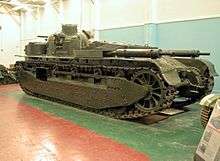Vickers A1E1 Independent
| Vickers A1E1 "Independent" | |
|---|---|
|
The Vickers A1E1 in 1925 | |
| Type | Tank |
| Place of origin | United Kingdom |
| Production history | |
| Manufacturer | Vickers |
| Number built | 1 |
| Specifications | |
| Weight | 33 long tons (34 t) |
| Length | 24 ft 11 in (7.59 m) |
| Width | 8 ft 9 in (2.67 m) |
| Height | 8 ft 11 in (2.72 m) |
| Crew | 8 |
|
| |
| Armour | 13–28 mm |
Main armament | QF 3 pounder gun (47 mm) |
Secondary armament | 4 × 0.303 Vickers machine gun |
| Engine |
Armstrong Siddeley V12 petrol 370 hp (280 kW) |
| Transmission | 4 forward, 1 reverse |
| Suspension | coil spring bogies |
Operational range | 95 miles |
| Speed | 20 mph (32 km/h) |
The Independent A1E1 is a multi-turreted tank that was designed by the British armaments manufacturer Vickers between the First and Second World Wars. Although it only ever reached the prototype stage and only a single example was built, it influenced many other tank designs.
The A1E1 design can be seen as a possible influence on the Soviet T-100 and T-28 tanks, the German Neubaufahrzeug tanks, and the British Medium Mk III and Cruiser Mk I (triple turret) tank designs. The Soviet T-35 tank was heavily influenced by its design.
Design
The Independent was a multi-turret design, having a central gun turret armed with the 3 pounder (47 mm) gun, and four subsidiary turrets each armed with a 0.303 inch Vickers machine gun. The subsidiary turrets were mounted two at the front and two to the rear of the turret (about halfway along the hull). The gun of the left rear turret was able to elevate to engage aircraft. The tank was designed to have heavy firepower, self-defence capability, and superiority to enemy weapons. It had a crew of eight men, the commander communicating with the crew through an intercom system. The Independent was never used in combat, but other armies studied it and a few adopted designs derived from it.
History

In 1924 the General Staff of the British Army ordered the prototype of a heavy tank, which became known as the Independent. Largely designed by Walter Gordon Wilson, its 35.8 litre V12 air-cooled engine was designed by Armstrong Siddeley. It also incorporated a new hydraulic braking system which had to be specially developed due to its weight and speed. The prototype was delivered to the War Office in 1926, and displayed to the premiers of the Dominions that year.
The tank was the subject of industrial and political espionage, the plans ending up in the Soviet Union, where they may have influenced the design of the T-28 and T-35 tanks. Norman Baillie-Stewart, a British military officer, was court-martialled in 1933 and served five years in prison for providing the plans of the Independent (among other secrets) to a German contact.[1]
It remained in use for experiments until 1935 when it was worn out and retired to The Tank Museum, Bovington, where it is preserved.[2]
Notes
- ↑ "Norman Baillie-Stewart Is Dead; Briton Jailed for Aid to Germans; Passed Secrets on Armored Vehicles Known as 'Officer in Tower'", The New York Times, 8 June 1966(subscription required)
- ↑ Fletcher (2014)
References
- Tucker, Spencer (2004). Tanks: An Illustrated History of Their Impact. ABC-CLIO. pp. 49–51. ISBN 1-57607-995-3.
- Garth, M, "Tank A1E1, Independent (E1949.331)", Virtual museum, The Tank Museum, Bovington
- Fletcher, David (14 January 2014), The Independent, The Tank Museum
External links
| Wikimedia Commons has media related to Vickers A1E1 Independent. |
